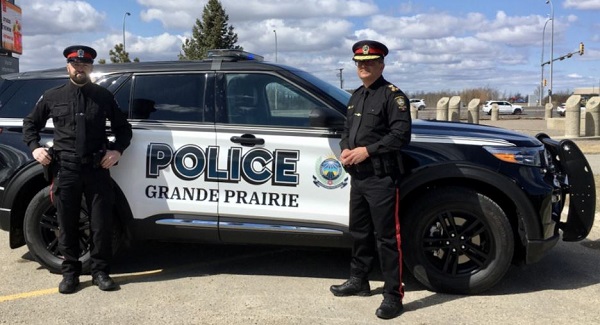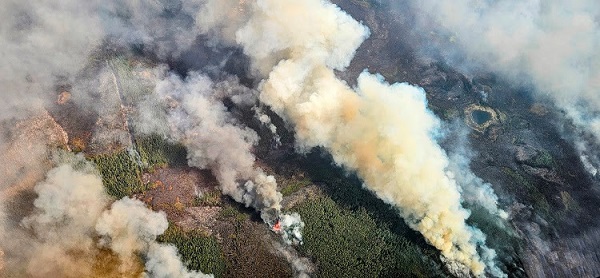Government of Alberta
Province investing to meet labour market demands by increasing access to “trades” education
From Government of AB
The province is providing more funding for scholarship programs for apprentices to meet labour market demands and increase access to trades education.

Lord Beaverbrook Grade 12 pipefitting student, Quinn Tubrett demonstrates welding skills to MLA R.J. Sigurdson from the Skilled Trades Task Force, Minister Nicolaides, Ray Massey, board chair of Skills Canada-Alberta and David LeMay, board member of CAREERS: The Next Generation.
Alberta is supporting high school students pursuing trades education by improving and increasing the scholarship program. The $1.5-million High School Apprenticeship Scholarship, which consolidates previous programs, will help more high school students access the education and training needed to get jobs in the trades.
“This investment will allow more young Albertans to access post-secondary education, through apprenticeship learning. We believe that a trades certificate has as much value, merit and worth as a university degree. When looking at post-secondary educational opportunities, I encourage young Albertans to give due consideration to the skilled trades. The trades provide a strong pathway to employment and to high-paying careers.”
“Our government has been working hard to strengthen the education system and support academic excellence and choice for our students as they prepare for their futures. These expanded scholarships will provide additional opportunities for Alberta high school students to pursue a career in the trades.”
“The High School Apprenticeship Scholarship will go a long way to recognize excellence and encourage our finest asset, Alberta’s youth, to continue their apprenticeship education and support them in their journey to reach their full potential as the future industry leaders on the world stage.”
“We are confident that the High School Apprenticeship Scholarship will be a valuable investment in the future of young Albertans, and ensure that they are able to pursue rewarding careers in the trades.”
“The High School Apprenticeship Scholarship is an important tool that recognizes that an apprenticeship is a valuable post-secondary education option and a career pathway that allows our young Albertans to achieve their own future career success as well as to become contributors to Alberta’s long-term economic prosperity.”
The province has injected an additional $1 million into the expanded program that recognizes the achievements of high school graduates who have chosen an apprenticeship pathway.
Qualified high school graduates in either the Registered Apprenticeship Program (RAP) or Career and Technology Studies (CTS) apprenticeship programs will receive a $1,000 scholarship. In addition, qualified graduates who have completed both a RAP and a CTS programs will receive a $2,000 Bright Future, High School Apprenticeship Scholarship.
Quick facts
- Over the past four years, an annual average of about 10,000 Alberta high school students in approximately 300 schools across the province participated in RAP and CTS classes.
- Over the last five years, an average of 344 recipients per year received the RAP/CTS Scholarship.
- More than 1,400 scholarships worth a total of nearly $1.5 million are being awarded for the 2019-20 school year:
- 1,387 High School Apprenticeship Scholarship awards valued at $1,000 each
- 35 High School Apprenticeship Scholarship – Bright Future awards valued at $2,000
- Over the next five years, nearly 20,000 skilled trades workers are expected to retire, with that number hitting more than 45,000 in 10 years. That’s equivalent to half the population of the City of Lethbridge leaving town.
Alberta
Alberta providing additional $7 million to Grande Prairie to help transition to municipal police service

Supporting homegrown policing solutions
Alberta’s government is following through on a commitment to ensure that communities can pursue policing solutions that meet their needs and are supported in reaching their public safety goals. That’s why the province is supporting the City of Grande Prairie with an additional $7 million in funding as it transitions to a municipal police service, helping to advance a homegrown solution that meets the needs of the community.
This new funding reinforces and builds on the province’s initial $9.7 million two-year commitment to help the City of Grande Prairie meet its policing and public safety needs, following the city council’s decision in March 2023 to transition from the RCMP to a municipal police service.
“Alberta’s government will do whatever it takes to keep people safe. The City of Grande Prairie is pursuing a policing solution that’s right for the community and its residents, and Alberta’s government is behind them throughout the transition process. Albertans, regardless of where they live, deserve fast and reliable law enforcement where and when they need it. Our government remains committed to ensuring Alberta municipalities have their choice of policing provider.”
Since 2023, Grande Prairie has made significant progress in hiring officers and civilian staff, procuring equipment, and beginning the development of essential IT infrastructure for a municipal police service. This support from the province ensures that the city can keep the momentum of its transition going as it lays critical groundwork for the Grande Prairie Police Service (GPPS).
The funding will support the projected start-up costs associated with building and implementing the new service, including salaries, benefits, recruitment, equipment and training. The GPPS is expected to become the primary police service of jurisdiction for Grande Prairie in 2026.
Once provincial startup funding through the Grande Prairie Police Service Grant agreement ends, the city will absorb all operational costs associated with its new police service. The annual operating budget of the GPPS is projected to be less than those associated with policing services contracted through the RCMP.
“The City of Grande Prairie is thankful for this announcement and the ongoing funding and support from the provincial government as we transition to a municipal police service. The transition is on budget and on schedule and has already provided a positive impact on our community safety and valuable insights on the modernizations that will be achieved with a stand-alone municipal police service model.”
“With the ongoing support and funding from the Alberta government, we are creating a modern, community-oriented police service that reflects the unique needs of Grande Prairie. The Grande Prairie Police Service is quickly proving that a policing transition can be both effective and efficient.”
Key facts
- The projected total cost of establishing and implementing the GPPS is $19 million.
- The GPPS is expected to become the primary police of jurisdiction for Grande Prairie in 2026.
- Through the Indigenous and Municipal Police Transition Study Grant program, Alberta’s government delivered more than $2.2 million in funding to help 35 municipalities, 23 First Nations and eight Metis Settlements to explore ways to enhance their existing policing models as well as alternate options such as self-administered First Nations policing or standalone police services.
- Under Alberta’s Police Act, towns and cities with populations greater than 5,000 are responsible for their own policing and can form their own municipal police service, be part of a regional policing arrangement or contract with the federal government for RCMP policing services to meet their public safety needs.
Related news
- Alberta funds community policing in Grande Prairie (Feb 22, 2023)
Alberta
New teams will boost Alberta wildfire preparedness

Alberta’s government is investing almost $7 million to create six new Wildland Urban Interface (WUI) teams to protect communities at risk from wildfires.
In response to increased wildfire activity in recent years, Alberta’s government is taking action to better safeguard communities and strengthen the way emergencies are responded to. This includes record investments in equipment and personnel, as well as targeted strategies to enhance local firefighting capacity, readiness and resilience.
Alberta’s government is responding proactively to wildfire threats by funding six local fire departments through the Wildland Urban Interface Program to boost wildfire preparedness and response capabilities. This initiative quadruples the number of existing Wildland Urban Interface teams, ensuring a stronger, more coordinated effort to protect communities from potential wildfire emergencies.
“Alberta’s government continues to make critical investments to strengthen the way emergencies are handled. We are effectively quadrupling the number of Wildland Urban Interface teams in Alberta to ensure the safety of Albertans’ businesses, neighbourhoods and critical infrastructure during wildfires.”
“Firefighting teams like this can truly make the difference when it comes to protecting Alberta’s communities. Having more Wildland Urban Interface teams improves our capabilities and adaptability when our wildland firefighting teams are fighting fires across Alberta.”
The Wildland Urban Interface Program targets zones where developments such as homes, farms or industrial sites border or mix with natural vegetation at risk from wildfire. Fires that occur in these transitional areas between forests, grasslands and populated communities are often challenging and demand the expertise of both wildland and structural firefighters. Wildland Urban Interface teams consist of firefighters who have the specialized training and equipment needed to respond to wildfires that enter a community or where developed areas meet wildland areas.
This program is a partnership between the provincial government and local authority fire services and includes funding from Natural Resources Canada. The province is responsible for coordination and funding, while local fire departments contribute personnel, firefighting equipment and resources. The expansion of this program will enhance the overall deployment of specialized resources across the province and improve municipal fire service capacity through additional training and technical support.
“The announcement of almost $7 million in funding to quadruple the number of Wildland Urban Interface teams will strengthen Alberta’s wildfire preparedness and significantly improve safety for Strathmore residents. As the local MLA, I am proud to support the growth of these versatile teams, which are deployed across the province to support municipalities like ours and reinforce our local firefighting capabilities.”
“Strathmore’s firefighters have repeatedly shown their skill, commitment and leadership during emergency deployments. Participation in the WUI Program allows us to strengthen those capabilities, enhance regional partnerships, and help build a sustainable response model for our community and province.”
Each new Wildland Urban Interface Team will receive $1.09 million over two to three years for personnel costs, administrative support, equipment, maintenance and travel costs to help develop and expand the program’s training and operational capacity.
The local authorities receiving funding are:
- Town of Strathmore
- Town of Hinton
- Town of Slave Lake
- Lac La Biche County
- Kee Tas Kee Now Tribal Council
- Kananaskis Improvement District
There are two existing teams based out of Clearwater County and the Town of High Level.
Quick facts
- Funding for the Town of Hinton, Town of Slave Lake, Lac La Biche County and Kee Tas Kee Now Tribal Council is shared equally between Natural Resources Canada and Alberta Forestry and Parks.
- Funding for the teams based in the Town of Strathmore and Kananaskis Improvement District will be provided by the Alberta Emergency Management Agency.
- Each team will receive a total of $1.09 million for a combined total of close to $7 million.
Related information
-

 Crime24 hours ago
Crime24 hours agoHow Chinese State-Linked Networks Replaced the Medellín Model with Global Logistics and Political Protection
-

 Addictions1 day ago
Addictions1 day agoNew RCMP program steering opioid addicted towards treatment and recovery
-

 Aristotle Foundation1 day ago
Aristotle Foundation1 day agoWe need an immigration policy that will serve all Canadians
-

 Business23 hours ago
Business23 hours agoNatural gas pipeline ownership spreads across 36 First Nations in B.C.
-

 Courageous Discourse20 hours ago
Courageous Discourse20 hours agoHealthcare Blockbuster – RFK Jr removes all 17 members of CDC Vaccine Advisory Panel!
-

 Health16 hours ago
Health16 hours agoRFK Jr. purges CDC vaccine panel, citing decades of ‘skewed science’
-

 Censorship Industrial Complex20 hours ago
Censorship Industrial Complex20 hours agoAlberta senator wants to revive lapsed Trudeau internet censorship bill
-

 Immigration18 hours ago
Immigration18 hours agoMass immigration can cause enormous shifts in local culture, national identity, and community cohesion
